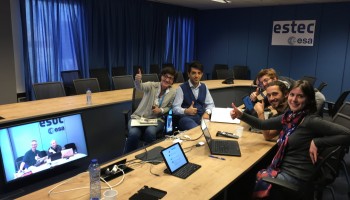We just wrapped up the first ESA Clean Space Twitter Q&A and it was great! A huge thanks to all participants for the many excellent questions, which we have collected below. From general queries and explanations on what space debris exactly are to how debris are defined to more specific queries regarding technologies for mitigation and space-policy related matters – they’re all below.

ESA Clean Space (Q&A) team – also note the ESOC colleagues D. Scuka & Holger Krag. Image: ESA/M. Trovatello.
Your questions were answered by:
- Tiago Soares – Clean Space system engineer
- Antonio Gabriele – Earth Observation Programme system engineer
- Luisa Innocenti – Head of Clean Space Office
- Holger Krag – Head of the Space Debris office
- Jessica Delaval – Clean Space Coordinator
- Sean Blair – Senior Editor Space for Engineering and Technology
- Daniel Scuka – Senior Editor for Spacecraft Operations
- Marco Trovatello – Cross-Media Coordinator

ESA Clean Space (Q&A) team — also note the ESOC colleagues D. Scuka & Holger Krag in the background. Image: ESA/L. Innocenti.
So, as this for sure wasn’t our last Q&A on how to make space more eco-friendly, we’ll be back with our next session sometime soon (we’ll possibly even try a reddit AMA next time).
A lesson learned already today is that we have to dedicate more time next time!
See you soon!
– The ESA Clean Space, Space Debris & Communication team





Discussion: 3 comments
As in a Sea or ocean solar flare are waves and when they come some objects can move or deorbit to Earth or Away from it right? How many objects (‘debris’ of the thousands totally floating or still orbiting regularly) can be potentially and relevantly be affected by solar waves and be brought to beach Earth with a powerful ejection effect? …
Can a regularly working satellite, a big one be brought into deorbit by a powerful solar flare within hours?
The Earth magnetosphere protect against solar particles although not completely.
The kinetic energy of a solar flare is not enough to directly significant change the orbit. However, the energy transferred via the electro-magnetic field will interact with the geo-magnetic field and cause the atmosphere to expand, which has an impact on the drag. In any case, not to de-orbit in a few hours (depends of the orbit of the satellite…). But, the charged particles transported by the wave may interact with the electronics of a working satellite and impede its functionality.
I`m studying a postgraduate course at University of Bilbao (Spain). I need some information to do a job, the information is technichal data of Clean Space One project, information like weigth, comunicattions and ohter technical information.
Thank you.